- Author Jason Gerald [email protected].
- Public 2023-12-16 10:50.
- Last modified 2025-01-23 12:04.
MRSA, which stands for Methicillin Resistant Staphylococcus Aureus, is a specific strain (microbial colony) of a group of staphylococcal (staph) bacteria that normally resides on the skin. MRSA is generally referred to as a super bacteria because it is resistant to antibiotics that can kill almost all staph bacteria. Although MRSA can live on the skin without causing any harm, these microbial colonies can cause serious infections when they invade the body through cuts or scrapes. MRSA infection looks similar to other, less severe infections, but can be very dangerous if left untreated. Read on and learn how to recognize the symptoms of MRSA.
Recognizing the Symptoms of MRSA
MRSA is a serious infection and can be dangerous if left untreated. Look for the following symptoms and seek medical care:
| Area | Symptom |
|---|---|
| Skin | Skin sores, bumps, inflamed body parts, rashes, necrosis in some cases |
| Pus | Fluid-filled lumps, ulcers, abscesses, stye/styes (on the eyelids) |
| Fever | Body temperature exceeds 38⁰ C, chills |
| Head | Headaches and fatigue may accompany serious infections |
| Kidney/Bladder | A UTI (urinary tract infection) can be a sign of spreading infection |
| Lungs | Coughing or shortness of breath may indicate spread of infection |
Step
Part 1 of 3: Recognizing Early Symptoms

Step 1. See if there are any cuts on the skin
MRSA infection is common when there is a cut or scratch on the skin. Take a close look at the hair follicles. MRSA infections are also common in areas of hairy skin, such as the beard, nape, armpits, legs, scalp, or buttocks.
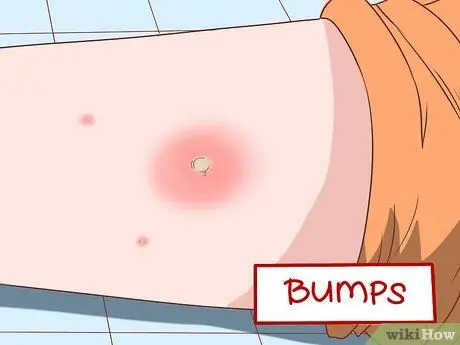
Step 2. Observe for lumps, redness or inflammation of the skin
MRSA manifests as a lump or area of skin that feels sore. This is often mistaken for an insect bite, such as a spider bite. Watch for any areas of skin that are red, inflamed, painful, or hot to the touch.
Watch for small bumps, cuts, scrapes, and redness. If the area becomes infected, see a doctor immediately
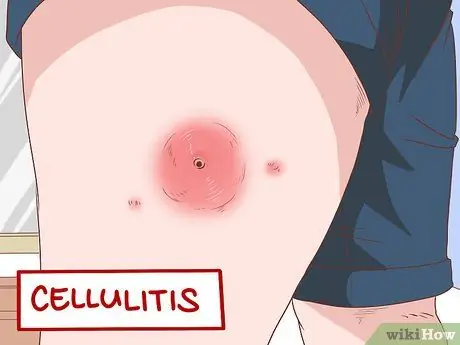
Step 3. Look at the area affected by cellulitis
Cellulitis is one of the symptoms of MRSA. Cellulitis is an infection of the layers and tissues under the skin that looks like a swollen, spreading rash. This infection causes the skin to look pink or red. Infected skin may feel warm, tender, or swollen.
Cellulitis can start as small red bumps. Some areas of the skin may look like bruises
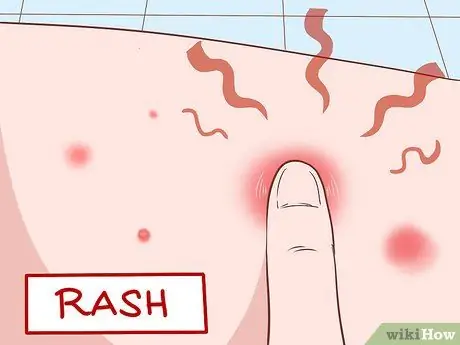
Step 4. Watch out for rashes on the skin
A rash is a red area of the skin. Be wary of having widespread areas of redness. See a doctor immediately if the area of skin that is experiencing redness feels hot, hurts/sores, or spreads quickly.
Part 2 of 3: Looking for Pus
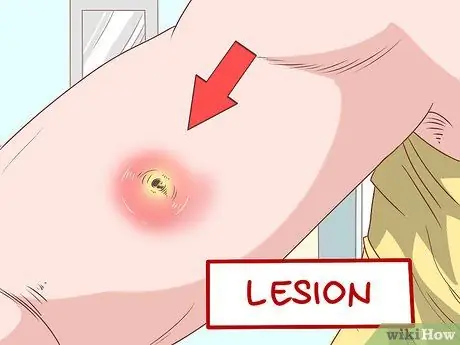
Step 1. Check if the wound is oozing pus
If you have a lump or sore, see if there is a fluid-filled cavity that can be moved or compressed. Look for yellow or white pus in the eye. There may also be pus that has dried.
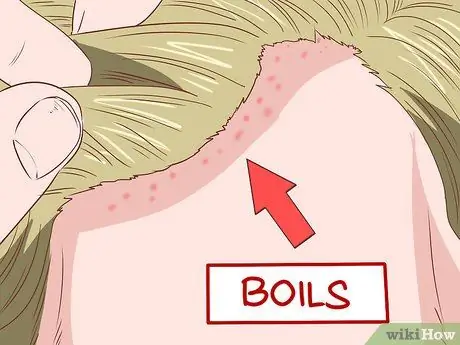
Step 2. Look for boils
Boils are infections of hair follicles that contain pus. Check for lumps on the scalp. Also, check for other hairy areas of the body, such as the "V" area above the pubic area, neck, and armpits.
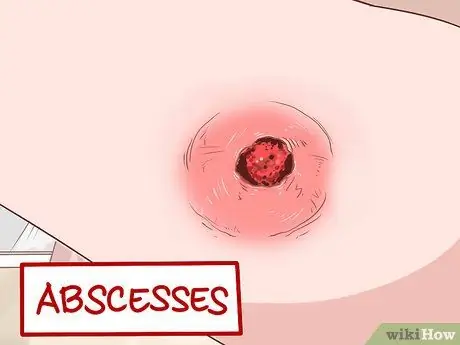
Step 3. Look for the abscess
An abscess is a painful pus-filled lump that is in or under the skin. Abscesses may require surgical suctioning of pus in addition to the use of antibiotics.
Watch out for carbuncles. A carbuncle is a large abscess filled with pus that has drained
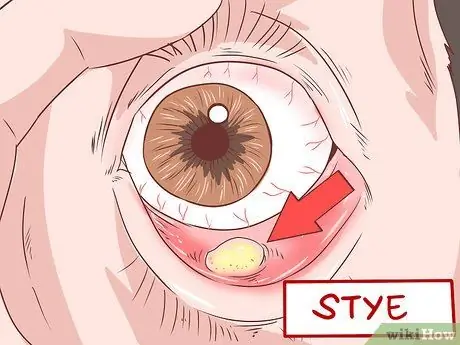
Step 4. Watch out for styes
A stye is an infection of the oil glands of the eyelids. This infection causes inflammation and redness of the eyes and eyelids. Lead can occur internally or externally. The bumps on the styes usually have a whitish or yellowish pus in the eye that looks like a pimple.
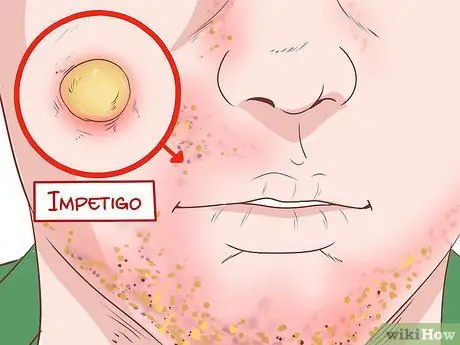
Step 5. Watch out for impetigo
Impetigo is pus that bulges on the skin. The pus bubbles can be large. Impetigo can rupture and leave a layer of brownish skin around the infected area.
Part 3 of 3: Treating an Acute MRSA Infection
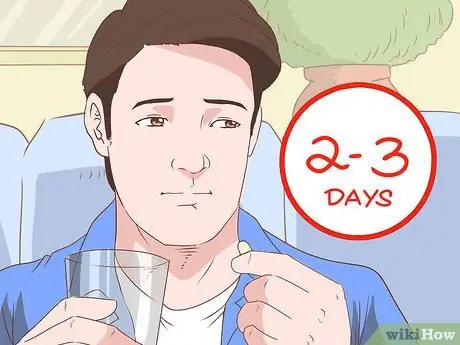
Step 1. Follow the development of body condition
If the doctor has diagnosed a staph infection and given antibiotics, the body's condition will improve in 2-3 days. If you don't see any progress, you may have MRSA. Be aware of the condition of the body and be prepared to return to visit the doctor soon.

Step 2. Watch for headaches, fever, and fatigue
These symptoms may indicate a serious infection when combined with a diagnosis of staph or MRSA. The combination may feel like flu symptoms.
Take your temperature if you feel you have a fever. A fever with a temperature of 38˚ C or more is a symptom to worry about

Step 3. Watch for signs of MRSA infection further
When it spreads to the body, MRSA infection can clog the lungs; swelling of the urinary tract; and will even start eating your flesh. Untreated MRSA can lead to necrotizing fasciitis, which is a terrible but rare flesh-eating disease.
- Watch for signs that MRSA has spread to the lungs. There is a possibility that the infection can spread to the lungs, if it is still not detected and left untreated. Watch for coughing, wheezing, and shortness of breath.
- A high fever and chills, which may be accompanied by a urinary tract infection, are signs that MRSA has spread to other organs, such as the kidneys and urinary tract.
- Necrotizing fasciitis is very rare, but not completely unknown. This disease may be indicated by severe pain in the infected area.

Step 4. Seek immediate treatment
If you think you have MRSA at any stage, act as quickly as possible before the bacteria find their way further into your system. Even if you're not sure, ask your doctor about it. MRSA can be a serious and life-threatening condition, and it's not worth taking any risks.
Tips
- Some of these symptoms are serious enough to require medical attention, regardless of whether they are related to MRSA or not.
- If the doctor prescribes antibiotics, it is very important to complete the entire course of treatment, even if the symptoms seem to have resolved.
- If you think you have any of the above symptoms, such as a boil or abscess, cover it with a bandage and call your doctor. Never try to solve it yourself as this can spread the infection to other parts of the body. The doctor will solve it if necessary.
- If you suspect a wound is infected with MRSA, cover it with a leak-proof dressing to prevent the infection from spreading while waiting for medical attention.
- Getting the MRSA test results can take up to a few days, so your doctor will treat you with an antibiotic that works against it temporarily, such as cleocin or vancocin.
Warning
- MRSA is too difficult to identify on its own. Call your doctor if you suspect you have any of these symptoms. Doctors will use diagnostic tests to decide whether you have this disease or not.
- You are at a higher risk of developing or suffering from more acute MRSA symptoms if you have a weakened immune system, and infections tend to be more fatal.






